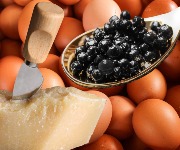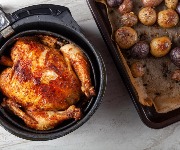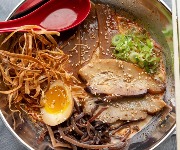Middle Eastern dips: Labneh
A strained yoghurt dip, labneh is a creamy, healthy and versatile dip both traditional in the Middle East and trendy on British menus.
Labneh is a dip made from strained yoghurt that is found across the Levant in Lebanon, Syria, Jordan and Israel. With a texture similar to that of cream cheese, you can see why it might sometimes be compared to curd cheeses, but labneh is in fact made solely from yoghurt.
It is a rare example of a dish made with a single ingredient and, provided you have a suitable piece of fabric to strain off the yoghurt’s whey, labneh is delightfully easy to make. I made mine with plain natural yoghurt, but for a more potent, almost feta-like flavour, go for a sheep or goat’s yoghurt. As we will see, there are a whole host of seasonings and variations on a simple labneh recipe, the only constants being yoghurt, some muslin cloth and a sieve.
How is it eaten?
Like any mezze, labneh is classically eaten with hunks of soft flat bread, and perhaps some pickles and olives, making for light eating at any time of day.It also makes good sandwich material. Lebanese chef and author Anissa Helou remembers coming home from school and her mother preparing a labneh with green olives and fresh mint leaves. Thicker labneh (which has been left to drain for slightly longer) is often rolled into balls and coated with different seasonings, like za’atar, chilli flakes or herbs. These can also sometimes be marinated in olive oil and make great finger food.
Tradition versus trend
When I spoke to Anissa Helou about labneh, we discussed its recent trendiness in the West, from London menus to American farmers markets. It’s a fashionable dish hailing from a region whose cuisine is still relatively obscure, but it’s also creamy without being unhealthy – another example of yoghurt replacing unhealthier alternatives without compromising on taste.
Helou is open to experimentation with tradition but is a purist at heart. Though she likes to play around with ingredients, she emphasises that doing so has limited acceptance in the Levant. Each country has its own approach (Syria uses sweet and sour tastes, for example, while Lebanese cuisine prizes simpler, cleaner flavours), but stress is always put upon understanding tradition in Arabic cuisine – how ingredients, flavours and dishes are used.
Like the UK, Israel is an example of somewhere that revels in playing with other nations’ cuisines – not just Lebanese and Syrian, but foods from Morocco, Yemen and Palestine. Israeli chef Yotam Ottolenghi champions labneh in his recipes and restaurants and is an example of someone using the dish innovatively though not necessarily according to Arabic tradition.
Making variations
Helou compares labneh to ricotta cheese: they are both pure, rennet-free and can be savoury or sweet. This makes labneh a hugely versatile ingredient. When NOPI launched, Ottolenghi served a dish of baby carrots with smoked labneh – a far cry from its traditional use but a dizzyingly beautiful flavour combination. Elsewhere, he has recommended it as an accompaniment to dessert, sweetened with sugar to sit next to tart fruit like rhubarb. Imagine a sweetened crème fraiche with a kick.
In Arabesque, Sam and Lucy Malouf share a recipe for “Saffron-Yoghurt Cheese”, just one example of how they have played with a labneh recipe. They suggest swirling in anything from saffron to garlic, spicy harissa, smoked paprika or fresh herb purees. See here for my labneh recipe.
More Middle Eastern delights
Win a trip of a lifetime to India
Most Recent
Comments
Be the first to comment
Do you want to comment on this article? You need to be signed in for this feature








